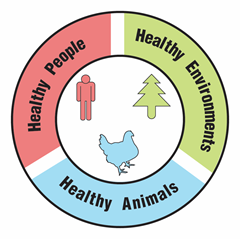One Health
 These lessons have been designed to increase students’ understanding of the concept of One Health, which emphasizes the connections between human health, the health of animals, and the health of the environment – with the goal of improving all health. Hands-on lesson components are easy to prepare and can be done with inexpensive supplies.
These lessons have been designed to increase students’ understanding of the concept of One Health, which emphasizes the connections between human health, the health of animals, and the health of the environment – with the goal of improving all health. Hands-on lesson components are easy to prepare and can be done with inexpensive supplies.
Resources for each One Health lesson include:
- A teacher guide with an answer key and information on how to prepare for the lesson
- Student handouts
Additional One Health activities have also been developed specifically for informal education and community settings.
Several of the One Health lessons have been adapted into virtual field trips. Click here for more information about LSLC’s One Health virtual field trips.
These One Health educational materials were developed with funding from Science Education Partnership Award R25GM132758 from the NIH National Institute for General Medical Sciences.
Follow the story of a young man who has a life-threatening case of food poisoning caused by antibiotic- resistant Salmonella bacteria. How did the bacteria become multidrug-resistant? How could the bacteria spread to humans, animals, plants, and the environment?
Follow the story of two college roommates as they explore possible protein sources in their diets. Are all protein sources equal in value? What effect does protein food production have on the environment? Why would someone choose to limit their source of protein?
- Student Guide
- Teacher Guide
Please email us for the answer key to this lesson
Bees are dying! Explore how the loss of bees will affect your food supply. Use simulated lab tests and data from scientific research to identify possible reasons for the decline of honey bee populations. Explore actions that could be taken to prevent protect insect pollinators.
- Student Guide
- Teacher Guide
Please email us for the answer key to this lesson
A man and his dog are both infected with heartworm, a disease that is caused by a worm carried by mosquitoes. Explore how an invasive species of mosquito combined with climate change can lead to an increase in heartworm and other diseases carried by mosquitoes.
- Student Guide
- Teacher Guide
Please email us for the answer key to this lesson
Doctors, environmental investigators, and veterinarians work together to identify the cause of an outbreak of encephalitis (a brain illness). What actions could prevent future outbreaks and protect the health of people, animals, and the environment?
- Student Guide
- Teacher Guide
Please email us for the answer key to this lesson
How are human health, animal health, and the health of the environment connected to each other? Students engage in an activity to model the decision-making process used by Dr. Kinari Webb to solve the problem of endangered orangutans in Borneo. The lesson is designed to provide students with an introduction to the One Health concept as well as to model a solutions-based method for decision making.
Follow a high school student as she volunteers at a local veterinary hospital. During the course of her internship, she helps diagnose a patient with a tick-borne disease. Examine the data to figure out why the incidence of tick-borne diseases are on the rise. What factors contribute to increases in ticks and the diseases they carry?
- Student Guide
- Teacher Guide
Please email us for the answer key to this lesson